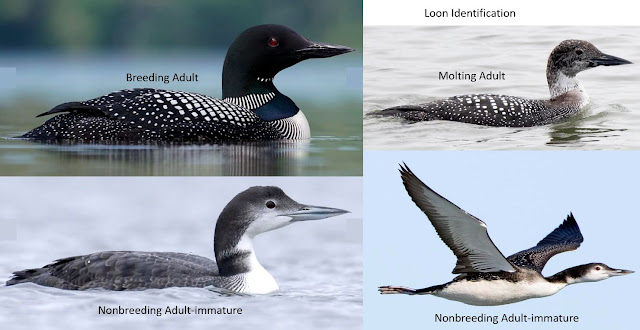 |
| #2862 "Pensive Loon" 14x20 inches oils on a smooth panel mounted on a stretcher frame built by my Dad |
The Singleton loon looked to be deeply or seriously thoughtful as it paddled slowly toward the viewer under the overcast and foggy skies. Perhaps I am just reading the pensive expression on its strong beak but it fits with the mood.
Ontario adopted the common loon (Gavia immer) as its official bird in 1994. The loon's eerie call is associated with the beauty and solitude of Ontario's wilderness. Like most things political, the effort was more talk than walk.
In 2006 I started working with a good friend to build and maintain floating loon nesting platforms throughout Red Horse and Singleton Lakes. We started with a fleet of more than a half dozen platforms. Over the years, the effort got to be too much. The water-soaked cedar log frames can be very, very heavy.
By 2016 I was down to looking after a single platform near our home on Singleton Lake. Since 2006 the Singleton loons typically produced two loonets a year. Loonets are often simply referred to as "chicks". Sadly, the Singleton loon nest failed in 2022 and 2023. The news was much better in June 2024 when two loonets were hatched.
 |
| The Ontario downward trend in successful loonets per pair is significant and obvious. |
 The adjacent photo shows the remaining loon platform before nesting materials were added. The "Respect Nesting Loon" sign added in 2023 is anchored about 25 feet from the platform to encourage boaters to give the area a wide berth. Singleton loons are especially afraid of paddlers.
The adjacent photo shows the remaining loon platform before nesting materials were added. The "Respect Nesting Loon" sign added in 2023 is anchored about 25 feet from the platform to encourage boaters to give the area a wide berth. Singleton loons are especially afraid of paddlers.
Adult loons are rarely predated except infrequently by bald eagles. Eagles will also attempt to snatch loonets from the water's surface. The family group of bald eagles on Singleton typically consists of 5 or 6 birds and they belong here as well.
Male and female Common Loons look alike except that the male is larger than the female - something impossible to discern unless they are together. Young Common Loons look similar to winter adults but have more white on their heads and back. This juvenile plumage is maintained through their first summer. In the non-breeding season (winter), the head and bill are grey, the neck is white, and the back plumage is grey with a scalloped pattern.
They are primarily diving birds who hunt for fish underwater in freshwater lakes and ponds. Their bright red eyes is to aid in their vision underwater. Unlike most birds, loons have solid bones which make them less buoyant. They conserve oxygen underwater by slowing their heartbeat. Loons can also flatten their feathers quickly to become more streamlined.
Loon pairs last, on average, six to seven years. Pairs often change when a loon challenger takes over a territory or a mate doesn't return to the territory after the winter. As the owner of a breeding area, the male loon returns first in early April. The female typically follows within a week.
Eviction from a breeding area is common in both sexes. The evicted loon moves to a non-territorial space nearby and begins to look for a new territory and mate. A loon whose mate dies or is evicted readily attempts to establish a new pair bond with a replacement bird. Experts call this behaviour serial monogamy.
There are four distinct loon calls:
- tremolo - The tremolo is an aggressive response given when disturbed by a boater or predator. The tremolo signals distress and may urge loons to move to safety. This wavering call also announces its presence at a lake.
- wail - The wail is perhaps the call most frequently heard. A loon will make this haunting call when it becomes separated from the chick or if its mate fails to return. It indicates a willingness to interact.
- yodel - The yodel is a territorial call given only by male loons. The yodel is also an expression of aggression and is given by the male during a confrontation. The yodel is used in territorial disputes, essentially stating to any loons close by – "This is our territory!" Each male has his own signature yodel. If a male moves to a different territory, he will change his yodel.
- hoot - The hoot symbolizes a call of curiosity and/or happiness. Hoots are soft, short calls given to keep in contact with each other: parents might hoot to a chick, or one mate might hoot to another.
A loon family can eat over a ton of small fish a year. The largest fish they can handle is up to about a pound in weight.
 |
| Sometimes a loon will even catch a substantial northern pike! |
Adult loons leave Singleton in late September well before the ice forms. This leaves the lake and the fishery to the youngsters who leave just before the lake ices over.
For this and much more art, click on Pixels or go straight to the Collections. Here is the new Wet Paint 2024 Collection.
Warmest regards and keep your paddle in the water,
Phil Chadwick






No comments:
Post a Comment